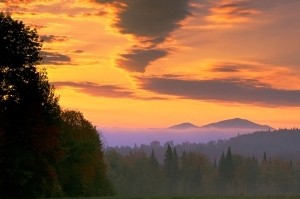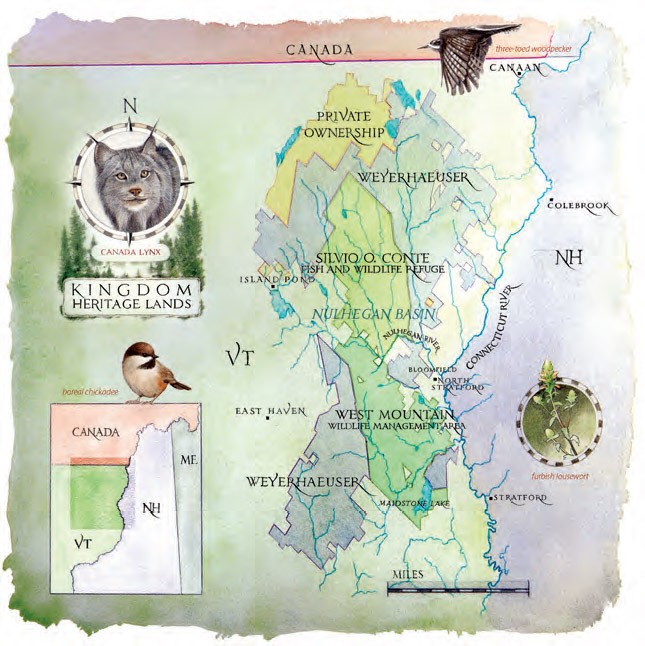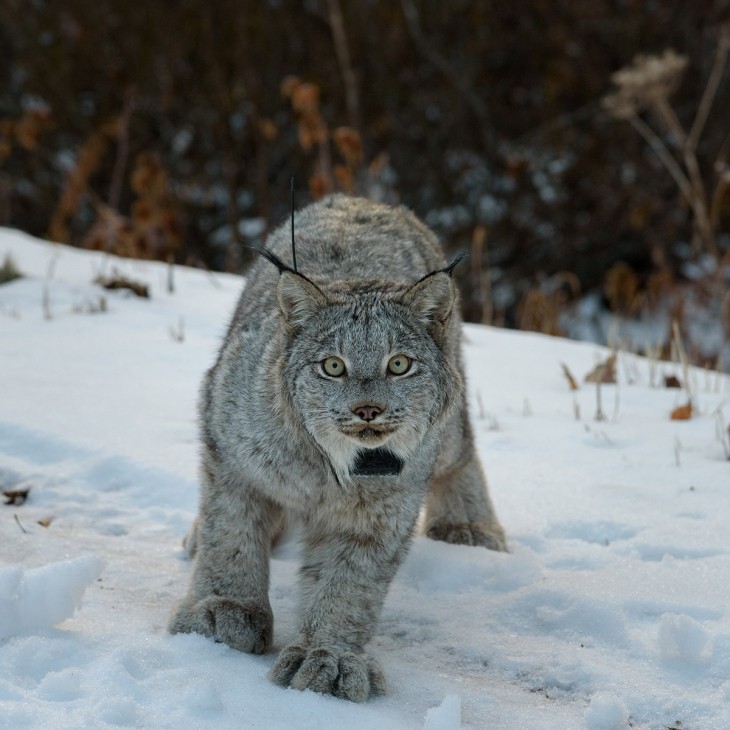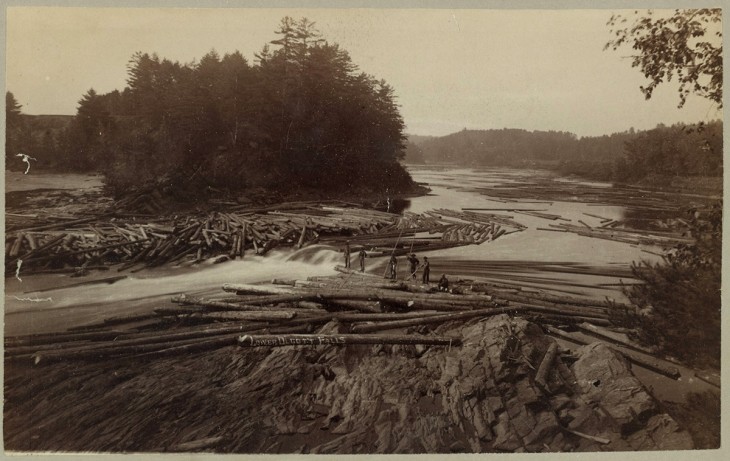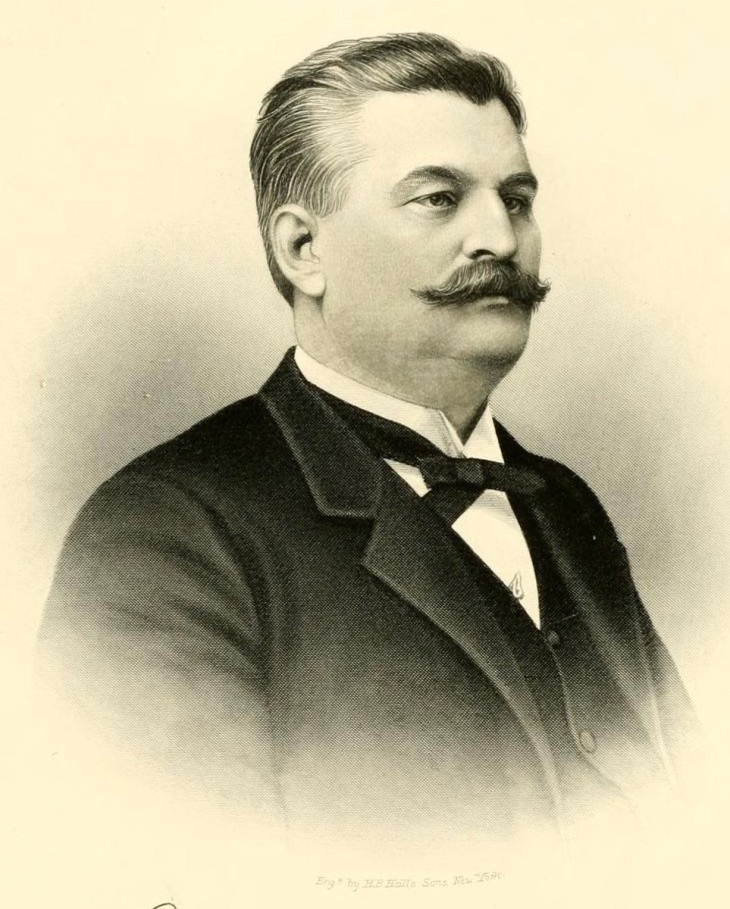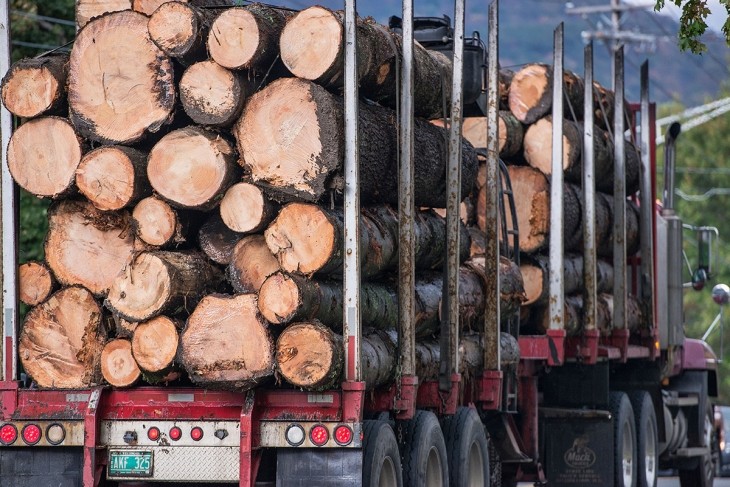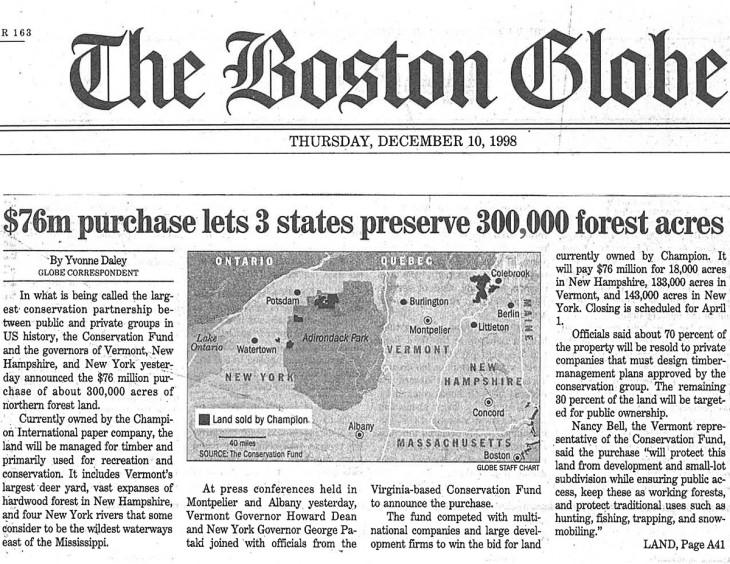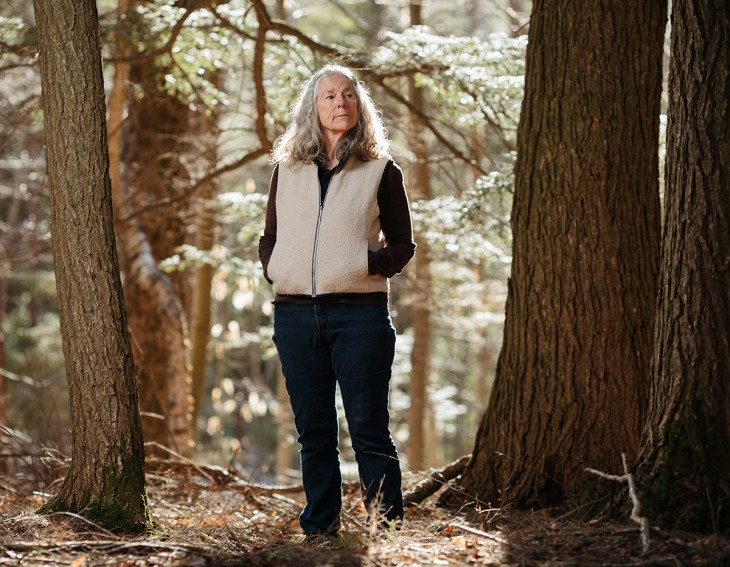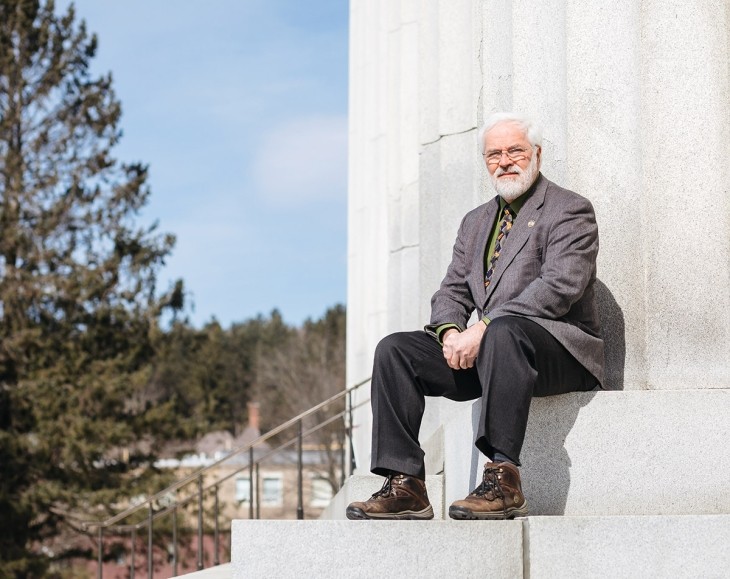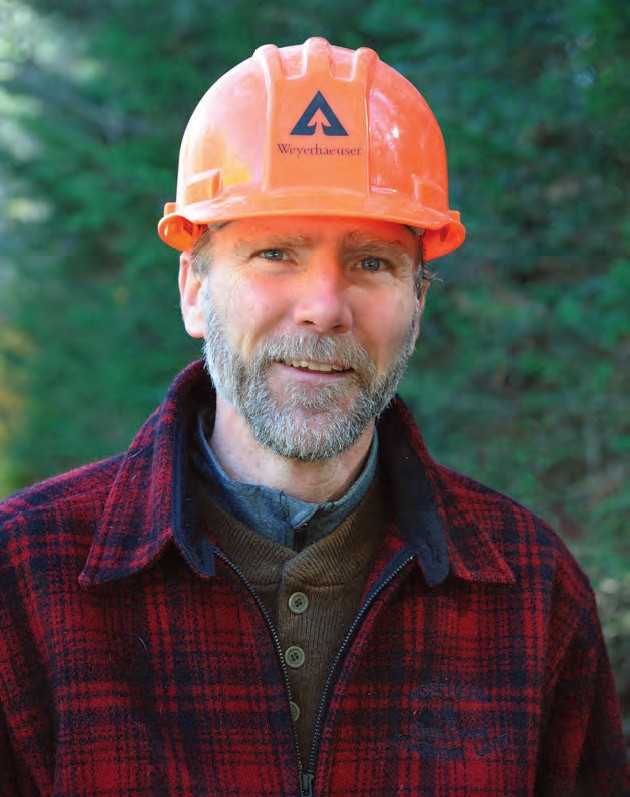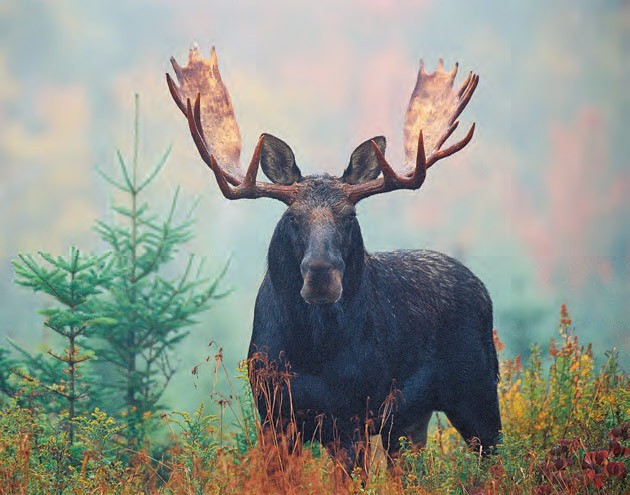Twenty years ago, an unprecedented land deal rocked northern New York and New England. The model of shared ownership that emerged changed the way land is conserved in the Northeast. Journalist David Dobbs revisits the former Champion Lands of Vermont’s Northeast Kingdom to find out how the ambitious and controversial deal has worked out.
On a late summer afternoon last year, the last afternoon free of fall’s edge, I took a walk through a densely wooded stretch of forest in Vermont’s North-east Kingdom, the state’s coldest, sparest, most remote region. Guiding me was Steve Agius, the lean and quietly well-spoken manager of the national wildlife refuge land we were traversing – the Nulhegan Basin Division of the Silvio O. Conte National Fish and Wildlife Refuge. Most of the refuge’s 26,500 acres consists of its namesake basin. Amidst the region’s corrugated, mountainous landscape, the Nulhegan Basin, formed eons ago by a cooling pool of magma, stands out as an almost flat and bizarrely circular dish.
Toting binoculars, we ambled north on Peanut Dam Road, a narrow dirt two-track. For Agius, an ornithologist and avid birder, my visit offered a rare chance to simply take a walk and bird. The refuge, created just 20 years ago, is a naturalist’s paradise of bogs, streams, and softwood forest – the most expansive spruce-fir lowland forest in Vermont. Most of it is early successional forest, growing back from clearcuts made two to four decades ago. Both the youthfulness of these trees and the names of the dirt roads and tea-colored creeks crisscrossing this basin bespeak its history as hard-working timberland: Canal Road, Stone Dam Road, Lower Tin Shack Road; the Yellow, Black, and Logger Branches, which, collecting the bogs’ tinted seepage, snake and slide south through the basin to join the Nulhegan River, which carries the water east into the Connecticut.
To our left, we heard the “peter, peter” of a tufted titmouse. As we tried to spot it through the dense foliage, a grouse exploded from the ground yet further left and flashed away through the tightly spaced trunks like a wraith. I looked at Agius, hoping he saw it better than I did. “Spruce grouse,” he said. Not the ruffed grouse more common in Vermont.
The spruce grouse, on the southern edge of its range here, is one of the refuge’s management targets. Also “of concern,” as conservation parlance expresses evidence-based ecological anxiety, are the three-toed woodpecker, the boreal chickadee, the red crossbill, the gray jay, and the lovely olive-sided flycatcher; an exquisite half-inch beast called the early hairstreak butterfly (“rare throughout its range”); and from the plant world, a poet’s embarrassment of riches: Dudley’s rush, moose-dung moss, auricled twayblade, furbish lousewort.
Another species of focus for the refuge, and a reason for my visit, is the Canada lynx, which after a long absence from Vermont returned 10 years ago in a series of sightings here in the Basin. The typical local combination of dense, tight undergrowth and heavy snow cover creates the favored habitat of the lynx’s favorite prey, the snowshoe hare. The dense growth helps the hares hide and escape from predators. Lynx come to such places to try to catch them anyway, and often do. In 2008, when refuge biologist Rachel Cliche (rhymes with ish) heard from an experienced trapper that he’d seen a lynx on the refuge, she was stunned. The lynx had been effectively extinct in Vermont since the late 1700s, with only four disconnected sightings in all the years since. But since that 2008 sighting, either the trapper, the refuge staff, or motion-triggered game cameras have spotted lynx or lynx tracks on the refuge every winter but two. Some sets of tracks indicated multiple adults. One set – a fresh group alongside a road – was made by an adult and three kittens.
This apparent return of the lynx, however tentative, is a testament to the value of creating this basin-sized refuge, which is to be managed for the lynx and other northern species, from three-toed woodpeckers to moose-dung moss, that are today re-populating the southern edge of their former ranges. Foresters may correctly note that it was industrial-forest clear-cutting that created these dense young spruce-fir stands that hares and lynx love. Refuge advocates can correctly counter that the refuge will provide a way to always manage for such stands, since the management plan includes regular small clearcuts to do precisely that.
The lynx and lousewort can also be seen as an affirmation of the larger land deal struck 20 years ago, commonly referred to as the Champion deal, that bought these 26,500 acres and another 105,000 acres of overharvested forest from the paper giant Champion International and moved it all into permanent conservation as either wildlife management areas or sustainably managed working forest. The conversion of the Champion lands was in part a test-run of a wider, multi-pronged approach to the conservation of land, habitat, forest economy, and rural culture. It has emerged as a guide to other land conservation efforts, large and small, that might occur throughout the rest of the 26 million-acre Northern Forest. The Champion deal was audacious, controversial, and hard-won. Two decades on, it is rightly hailed as a success. Never will these 132,000 acres of Vermont be cut to pieces, developed, or (with a few minor, strategic exceptions) built upon; yet they remain a central part of the region’s economy and culture, for virtually all of these acres remain open to the public, and two - thirds are privately held forest that, by easement, will forever be sustainably managed for timber.
The Champion deal is working well enough, in fact, that people working and living in the Northeast Kingdom seldom talk of it now. Its improbable success – which happened partly because the people leading it, including a self proclaimed hippie and a governor, “didn’t know it was impossible,” as the hippie put it, “so we did it” – was struck only after two years of hurried, often rancorous and even savage debate.
On one side were those who saw in the Champion sale a chance to try a new approach to large-scale conservation that equally honored ecology and economy, nature and culture. On the other were people who saw that solution as a state and federal land grab and a threat to their entire way of being, their livelihood, and the intimate if sometimes rough-textured links between their identity and the land’s.
The Pull and Power of Money
The links in this land’s chain of ownership are surprisingly few. For some 3,000 years, the Western Abenaki had a small but stable culture along both sides of the upper Connecticut River Valley. Here, in scattered villages, an estimated 2,000 people farmed, fished, hunted, and traded basketware and other goods. When a village found easy firewood getting scarce, it would move a few miles to fresher forest. The forests were also crucial to the Abenaki strategy, once Europeans began penetrating north up the Connecticut around 1600, of dispersing into smaller groups and hiding – a tactic, alas, that later encouraged inaccurately low population estimates in land-rights disputes, and which in any case could not protect them from the decimation by smallpox, yellow fever, and other diseases that even friendly outside contact brought them.
As European settlers took possession of the land, the forests for two centuries changed hands mostly in small holdings that were farmed or logged, with the logs – the best of them reserved for the King of England’s navy – floated to mills down the Connecticut. Trees, having become property, were thereafter subject to the pull of power and money.
The first person to buy up these lands in an organized fashion was a short, smart, profane Vermonter named George Van Dyke, “a forthright, violent man,” as Robert Pike relates in Tall Trees and Tough Men, “a tremendous worker.” Born dirt poor in 1846, Van Dyke would die filthy rich in 1909. In between, he leveraged four years of school, fifteen years of woods work, boundless ambition, and limited scruples into a timber and railroad empire that dominated northern New Hampshire and Vermont and the river in between. By 1900 he was worth an estimated $10 million, and his Connecticut River Lumber Company owned a wide swath of the forest spanning the upper river. The holdings included what would become the Champion lands of Vermont – roughly 150,000 acres spreading west and south from the company’s headquarters in the tiny town of Bloomfield, Vermont, where the Nulhegan meets the Connecticut. Van Dyke still held those lands when, on August 8, 1909, the motorcar in which he sat watching his biggest log drive ever, 53,000,000 feet of lumber sluicing through the dam at Turner’s Falls, Massachusetts, rolled off a 75-foot cliff and smashed onto the rocks below. He died a few hours later.
By then, the timber-baron era had already begun its own gradual death, as the turn of the century saw the formation of America’s first big pulp and paper corporations, including Champion Coated Paper, originally of Ohio; International Paper, of Memphis; and St. Regis, which built its own company town, Deferiet, on an island in the Black River in upstate New York. These vertically integrated corporations needed timberlands to feed their mills. In 1927, St. Regis bought Van Dyke’s company and lands to provide pulp for its ever growing Deferiet mill. In 1984, in another round of paper-industry mergers, St. Regis sold both the mill and 440,000 acres in New York, Vermont, and New Hampshire to Champion, which was vying with International Paper to dominate the U.S. paper industry.
At the time, says Richard Carbonetti, an independent forester, land manager, and consultant (and current Northern Woodlands board member) who worked closely with Champion on its Vermont and New Hampshire lands in the years that followed, the company responded to the era’s intense profit and takeover pressures by dividing its timberland holdings into “fiber centers,” which would feed its mills over the long term, and “profit centers,” which would be harvested and/or sold for short-term profit. It put the 330,000 acres it had just acquired in New York, Vermont, and New Hampshire in the profit-center bin.
It was stunning, says Carbonetti (echoing many others) to see the result. Carbonetti, who was often on Champion’s Vermont lands inventorying or directing cuts of the woods, estimates that those acres grew an average of around 132,000 cords of wood a year. In the early and mid-1990s, he says, the company was cutting at a rate of 250,000 cords a year – almost twice the growth rate. The effort pulled loggers from far and wide, including from over the border, in Quebec. “There wasn’t a lot of forestry going on,” he says. “It was, ‘We have trees. Let’s cut them.’” Many of the loggers, he recalls, could hardly believe what they were watching.
Finally, in the mid-1990s, at a spring meeting of all its logging contractors at the Northland Restaurant and Lounge in Canaan, Vermont, Champion management announced it was reducing the harvest to 85,000 cords a year. “Simultaneously,” says Carbonetti, “you heard people all over the room say under their breaths, in English and in French, ‘They finally figured out there’s no fudging wood left.’ They didn’t say ‘fudging.’ Everyone knew the gravy train was done.”
Soon after that, in October 1997, Champion announced it was selling all 330,000 acres across the north country.
The Anatomy of a Deal
As Champion was preparing its announcement, an unstoppable wild-haired 50 something conservation activist named Nancy Bell, a “hippie” by her own description, was spending a vacation climbing mountains far from Vermont. She had spent most of the prior eight years fighting, without pay, what at times was a one-person legal fight with a Vermont ski resort to preserve 5,000 acres of bear habitat in a place called Parker’s Gore. “It was war,” she said. She had won, and victory had led to a half-time job with a new national conservation outfit called The Conservation Fund, which wanted to forge new ways to con serve land. But Bell had hated that fight, and in the mountains far from home she began to realize why. She realized she didn’t understand her opposition, never had and never really tried to, and because of that she had approached them in ways that put them off right from the start, and from there things usually went downhill. No one listened. Everyone responded solely to the fear of losing. “I thought, this is crazy.” Why did a process aimed at reaching agreement feel like war? She hoped to find some better way to get such things accomplished. Her climbing vacation did not directly show her how. But at the top of the last mountain she climbed on that vacation, Bell thought to herself that it’d be nice, having conserved 5,000 acres, to find a way to save much more before she died. Maybe some big round number, like, say, 100,000 acres.
A few days later she returned to Vermont and promptly learned two things. One was that Champion had just announced it wanted to sell 330,000 acres, 132,000 of them in Vermont. The other was that The Conservation Fund wanted to buy it all and somehow conserve it, and they wanted her to be their person on the ground in Vermont.
What followed was an “enormously difficult” process, but also “a once in a lifetime opportunity,” as then-Vermont governor Howard Dean would later recall. For Bell and the others at The Conservation Fund, it was something like herding cats while walking a tightwire. The idea was for the Fund to buy all the land as soon as possible, lest it get bought by someone else and subdivided, and then move it, protected by conservation easements, into a mix of public and private ownerships – an approach that had gained currency through the Nature Conservancy and the land-trust movement. The Fund’s add-on was ambitious: it wanted to leave most of the lands in forest production, but with strong easements guaranteeing public access and sustainable, wildlife-friendly forest management.
If the template was roughly familiar, applying it to 330,000 acres in three states was far beyond anything the Fund had done before – beyond almost anything ever done in the Northeast, for that matter. Even just the Vermont portion, 132,000 acres, would be unprecedented. But “after due, extensive deliberation” of a week, jokes Evan Smith, a key player on the small Conservation Fund leadership team, they decided to go for it. (“If it failed,” he added, “we were finished.”) The first impossible thing they did was convince Champion to give them two years to raise the asking price, $76.5 million. During that time, they would have to not just raise the money, but find conservation and scientific partners to help them with natural resource inventory and planning; gather and solidify political support from forestry, conservation, industry, recreation, state, and federal interests; work out how to structure the deals so towns would not be shorted tax revenue; and find a buyer for the tens of thousands of acres that would remain working forest.
It was a frenzy, with endless fund-raising, horse-trading, easement negotiations, and lobbying. To get it all done, they recruited others with similar interests, including the Nature Conservancy, the Vermont Land Trust, and the Vermont Housing and Conservation Board. A scientific committee helped inventory the forests and other natural resources. And Vermont governor Howard Dean, who was all in from the start, convinced key legislators in the Northeast Kingdom and across the state to back the effort.
“There were so many times,” says Dean, “when we thought the whole thing was going to fall apart.” Yet as the Fund and various players put together one piece after another, a workable plan came into shape. The Fund, biting its nails and hoping it would find the money, would buy the entire 300,000 acres for $76.5 million; in the Vermont portion, it would immediately sell 26,000 acres to the feds for a national wildlife refuge and another 22,000 to the state for land that would become the West Mountain Wildlife Management Area, thus recouping a bit over $10 million; the remaining 84,000 acres would be protected by easements, a process that was financed with $4.5 million from a State budget surplus. The easements would restrict cutting and guarantee public access, and the land would be sold to a new, conservation minded forest management company called Essex Timber. They signed the contract in October 1998. Champion gave them a year to get the money together and close the deal.
The hardest and most crucial part of all this, meanwhile, was getting the people who lived in those areas to accept the concept. Many Kingdom residents, as well as others who worked or often visited there, felt this enormous change threatened to destroy an entire culture and way of life.
Among those was Ed Larson, a forester in his mid-40s who lived in northern Vermont and often worked in the Northeast Kingdom. The only thing he and his friends heard, at first, he recently told me over lunch in Montpelier, was that a conservation group wanted to conserve the land. This was roughly as welcome as someone from the federal government knocking on the door and saying they were there to help.
“We were worried as hell. We thought we’d lose a lot of land to logging forever. That we’d hardly be able to cut anything.
“But it was way more than that.” As foresters, loggers, hunters, and snowmobilers – “hardworking people, regular types, you know what I mean,” said Larson with a sly smile – he and his friends had too often seen or heard environmental activists act or talk in ways that seemed to dismiss their love and knowledge of the land and to assume they were blind to anything beyond its economic value. They felt that the people proposing this deal were not just from another class, but another culture altogether, one whose privilege left them indifferent to any changes that could make these lands less valuable as working woodlands. They hated the feeling of being looked down upon for the different, seemingly rougher way they interacted with the land. “We worried this whole culture would be lost. That this would be the end of the Wild, Wild West of Vermont. You know,” he said, smiling, twirling his fork in the air, “hunting and fishing. Snow machines. Shootin’ guns from the road. Redneckin’ in the woods. All that.” Then, more seriously, “But yeah. Hunters, fishers, trappers, camp owners, loggers, snowmobilers. We were all scared.”
Larson, seeing how widespread this fear was, found himself lobbying against the deal, first informally and then as a paid lobbyist for the Vermont Forest Products Association and a group he helped start called the Vermont Traditions Coalition.
Bell, meanwhile, who had been thrown out of at least one acrimonious public meeting herself, says she felt sympathetic with what she called that “backcountry outlaw” culture. She wanted the deal to help preserve that culture. Driving up to Vermont’s northernmost reaches, she visited loggers and scalers and foresters and hunters and trappers and skidder salespeople in towns like Brighton, Island Pond, and Charleston. Talked them up, listened, asked to hear more. She asked if she could come to their hunting club meetings and logging sites. Walked traplines and went snowmobiling. Most of all she listened.
“It was a matter of getting into the culture and not resisting it,” she says now. “The listening – ask what they care about and then just listen – that meant more than anything. I had to suspend all judgment and just be with people. For so many of them this was their landscape. You listen and listen and listen and understand the visceral love that people had for this land.”
What she heard most clearly was that they didn’t want to lose the land. They wanted to still go there. The access piece – actual physical contact to land they felt was part of them – “was huge. That was the common ground.” She told herself: So keep things close to the ground.

The light green of young trees shows a selective patch of clearcut, West Mountain Wildlife Management Area. Part of the long-term management plan, such cuts will continue to be used to increase biodiversity and improve habitat for species ranging from spruce grouse to Canada lynx.
Photo by Ben Silberfarb
She explained the easements that the fund and its partners had in mind. The biggest chunk of land, the private stuff, 84,000 acres, which was two-thirds of the entire 132,000 purchase, would always be kept in one piece, she told them, would never be developed as real estate, would always be managed for sustainable wood harvests. It would be an eternal source of timber and logging jobs. And it would never be posted.
Of the remaining 48,000 acres, 22,000 acres in the southeastern part of the tract would become a state wildlife management area with public access, while 26,000 in and around the ecologically sensitive Nulhegan Basin would become a national wildlife refuge. In an extraordinary exception to its usual practice, the US Fish and Wildlife Service would include in its management plan the continued allowance of snowmobiles on the property in winter.
The trappers, says Bell, got it right away, as did most of the hunters. The snowmobilers, too, who knew how quickly lands sales and subdivisions could erode a snowmobile network. Many of these people would tell her that they supported what she was proposing, but couldn’t say so in public. At first this distressed her. “I’d be at a public meeting, and there’d be people literally talking about the feds coming in black helicopters,” and she’d wish dearly that one of her quiet allies would stand up and push back. Yet she slowly perceived that such allies were changing minds and winning her support in other, more private venues. It dawned on her that the slow-perc approach might actually work. Connect with people away from meetings, and hope it seeped through. And increasingly at public meetings there would be moments, she recalls, “When people would have an insight and see that it wasn’t threatening, or someone would make a comment in the midst of everything, saying, ‘If somebody buys it all and posts it, then we’re all out of luck.’”
The last obstacle was the camp owners – people who owned rustic cabins or camps on one-year renewable leases on Champion lands. Such camps had long been common all over industrial forestland in northern New England, and despite the tenuous one-year renewable leases, which could be canceled at any time, the camps on Champion lands had become cherished and often foundational parts of the lives of the families who owned them. In the end, the camp owners accepted another exceptional part of the deal: the leases would be honored through the life of the current owner plus 20 years. (On the state lands, this was later changed, in response to camp owners’ requests for more clarity, to leases honored at least until 2059.)
Ed Larson, pondering the deal today, agrees with others, including his former opponents of the deal, that overall it must be considered a success. During those two crucial years, his lobbying effectively turned from opposing the deal outright to pressing for less onerous terms. He and his clients wanted to preserve cutting, camps, and access for hunting, fishing, snowmobiling, and hiking – essentially, to have what they did before. They got nearly all that. Larson is upset, though, that 12,500 of the state wildlife management area’s 26,000 acres became a core natural preserve off limits to all development and motorized traffic. “Still a thorn in our side,” he says. Yet his friends and clients accepted the core preserve as part of a larger deal that gave them non-motorized access in the core and motorized access to the rest of the state land as well as permanent logging and recreational access on all the industrial land.
Logging forever on an 84,000-acre tract, he admits, “is a pretty big deal.” Some of Larson’s logger friends and clients still work on that land. It’s now owned by Weyerhaeuser, which bought the parcel as part of a 2015 purchase of Plum Creek Timber, which had bought it from Essex Timber in 2007.
For Weyerhaeuser forester Chris Fife, who also worked these lands as a forester for Plum Creek, helping to manage this tract (which has since added 2,000 acres) has been a chance to do things differently from the old Champion days. Fife’s team manages not for pulp or cordage, but for high-value sawlogs and long-term sustainable production.
This is not just talk, but a legal obligation. The company must operate in accordance with both the conservation easement held and enforced by the Vermont Land Trust and sustainability measures specified in the current-use property-tax reduction plan the company has with the state. Overall, says Michael Snyder, Vermont’s commissioner of forest, parks, and recreation, Weyerhaeuser’s management has been good.
Much of Fife’s work is designed to steer these formerly hard-hit woods toward the easement’s goal of sustainable harvests that support the local economy while protecting water quality, ecological integrity, and wildlife. This means management plans protecting critical habitat that supports threatened and endangered species; allowing riparian buffer zones to recover; and even – in partnership with Trout Unlimited – arguing for a special exemption to cut trees along the East Branch of the Nulhegan River and its tributaries and drop them into the river at strategic locations, to restore natural cover and improve brook trout habitat. It also means thinning low quality, low-value species to release more valuable species, such as maple or white pine, that will grow into quality sawlogs. “If we do a shelterwood harvest on a poor-quality stand today,” Fife points out, “the future high-quality sawlogs won’t be harvested for 90-plus years.”
For now, sawlogs are scarce. Fife says that for the next decade the company will harvest about 29,000 cords each year, 27 percent hard- or softwood sawlogs most years, and 73 percent pulp. The wood goes to lumber, railroad tie, pallet, or veneer mills in Vermont towns including Newport, Albany, or Beecher Falls and in neighboring Quebec; or as pulpwood to Maine. The plan is to keep that steady flow with a focus on harvesting that gradually increases the volume of sawlog trees while maintaining a diversity of tree ages and species.
Ed Larson is glad to see all of this; glad especially to see loggers and mills getting work from the land. His ire has softened. He even bought a camp in the state’s wildlife management area – a place from which to hunt, contemplate, go redneckin’. Through much of the last 20 years he has considered the state’s Department of Forests, Parks, and Recreation a foe. Now one of his closest associates and allies, a longtime farmer and logger named Sam Lincoln, who was a member of the groups Larson lobbied for, is the department’s deputy director. He was invited there by Governor Phil Scott in 2017 at the urging of Larson and others.
“So I guess it’s working,” says Larson with a chuckle. “We feel heard.”
The Next Big Deal
The Champion deal’s true distinction is not the protection and conservation of this landscape, but its recognition of the breadth of our cultural and personal connections to it. For this reason, the state’s proposed moniker for the region, which has so far failed to catch on – the Kingdom Heritage Lands – is quite apt.
While the land is conserved in perpetuity, that doesn’t mean things will always stay the same. Larson worries about what will shift in the culture when the camps are finally taken out, with the woods roads following. Climate change, as it does everywhere, looms as a unique and formidable threat to the future of both this ecosystem and its human heritage. Virtually everyone I’ve talked to lately who works in this forest, whether wildlife biologist or forester, birder or logger, town manager, refuge manager, or land-investment manager, is being forced to rework their assumptions, models, and visions of what this area is and will become.
Some pretty stark changes are already here. Wetter summers, more frequent heavy rain events, and earlier break-ups in the spring, for instance, have cut into the number of days loggers can be in the woods working, making an already tough living even tougher. Over the past decade’s less snowy winters, to pick another example, moose biologists in Maine, New Hampshire, and Vermont have seen a climate-driven wave of tick irruptions begin to decimate those states’ moose populations. Moose calves in these milder winters are collecting up to 50,000 or even 100,000 ticks, which thrive in warm, dry winters and literally suck the life out of over half the calves. Having returned to the Northern Forest over the last 30 years after a century gone, the moose may well be driven out once more.
Also dependent on snow is the Canada lynx. For the past five years, Alexej Sirén, a wildlife biologist at the University of Massachusetts, Amherst, has been using hundreds of camera traps to monitor and study lynx populations in the Nulhegan and elsewhere in the Northern Forest. Sirén says that the study of animals at the margins of their usual habitats – their “range edges” – has been a staple of wildlife biology since Darwin’s day. Now, as climate change pushes some species poleward, range-edge studies show that an animal population living in its usual range’s warmer “following edge” faces unique strains. For one thing, genetic diversity, and thus resilience, decreases. And as the local climate warms, an animal in its following range-edge will face increasingly intense competition from its southern rivals – in the lynx’s case, the bobcat. When I offered to Sirén that it seemed our warming climate might thus drive the lynx, too, out of Vermont – perhaps out of the entire Northeast – he managed a grim smile and nodded.
In the long term, as Vermont forest ecologist and historian Charlie Cogbill likes to point out, the forest itself will be okay. It will become what it needs to become. Possibly less resilient, however, yet soon to be sorely tested, is our relationship to these woods. The bond we have to them is not just to land, property, or acreage, or even to birding, kayaking, forestry, fishing, hunting, logging, or shooting guns from the road. It’s to a distinctly northern landscape and culture – an edge culture, if you will – where the southern margins of the boreal forest lap into the northernmost parts of the United States. Here, an increasingly diverse rough-hewn American individualism tests and liberates itself in the demands and pleasures of a cold and spare region. It is, as they say, a whole different country. The Wild Wild North.
It now seems near certain that some of this place’s greatest distinctions – iconic species like moose, lynx, marten, brook trout; irreplaceable sights like that of yellow tamarack, black spruce, and blazing maple reflected in the still dark water of a northern pond – may disappear. Can our bond to the place survive such a loss? Can a culture that rose from such a particular habitat persist if that habitat and its iconic denizens essentially move out of reach? Does the land’s very identity change? Does ours?
This will be this region’s next big challenge. It seems almost impossible. Somehow, again, we’ll have to find the resilience, patience, and humanity to meet it anyway.
Journalist David Dobbs writes about nature and science for The New York Times Magazine, National Geographic, and other publications. He is co-author with Richard Ober of The Northern Forest, which won the 1995 Sigurd S. Olson Nature Writing Award.
The Resilient Forest Series - Part 1
- Heritage Tested
- Heritage Land
- Logging by Hand
Our special thanks go to the Emily Landecker Foundation, the Dorr Foundation, the Davis Conservation Foundation, the Larsen Fund, Melinda Richmond, and the Samuel P. Hunt Foundation for their support of this work.


